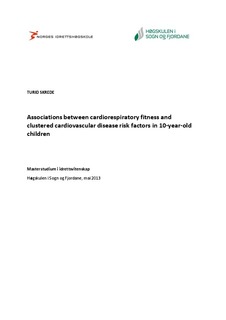Associations between cardiorespiratory fitness and clustered cardiovascular disease risk factors in 10-year-old children
Master thesis
Permanent lenke
http://hdl.handle.net/11250/150394Utgivelsesdato
2013Metadata
Vis full innførselSamlinger
Sammendrag
Background
Risk factors for cardiovascular disease (CVD) origins in childhood and tend to track into adulthood. Epidemiologic studies have established that multiple risk factors increase the probability of cardiovascular events, since CVD risk factors tend to reinforce each other in their influence on morbidity and mortality. CVD develops over decades; therefore, it is important to prevent unfavorable lifestyle through cardiorespiratory fitness (CRF) behavior. Therefore, the aim of this study was to investigate the association between children’s CVD risk profile and different measurement of CRF.
Methods
Forty-eight boys (n=28) and girls (n=20) from Trudvang School in Sogndal, 10.2 years of age, completed a maximal treadmill test (VO2peak) (direct test) and the Andersen-test (indirect test). Blood samples, height, weight, waist circumference and blood pressure were assessed.
Results
VO2peak and a clustered CVD risk score were significantly associated (P=0.046). Overall, the participants with lower clustered CVD risk score had significant higher CRF had than participants with high clustered CVD risk score. Among the five risk factors (waist circumference, systolic blood pressure, triglycerides, total cholesterol and glucose) only waist circumference was independently associated with CRF.
Conclusion
There is a significant association between clustered CVD risk score and CRF; thus, high CRF is associated with a lower clustered CVD risk score in children. Furthermore, the 25 % children with least favorable clustered CVD risk score performed consistently lower CRF. An important finding is that clustering of CVD risk factors for also apparent in a relative healthy and homogeneous sample with a high VO2peak. The present study shows that indirectly measured CRF (the Andersen-test) could detect children with unfavorable clustered CVD risk score.
